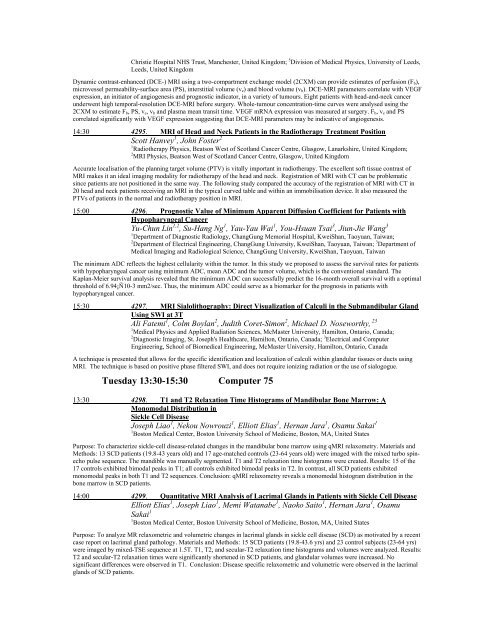Electronic Posters: Neuroimaging - ismrm
Electronic Posters: Neuroimaging - ismrm
Electronic Posters: Neuroimaging - ismrm
Create successful ePaper yourself
Turn your PDF publications into a flip-book with our unique Google optimized e-Paper software.
Christie Hospital NHS Trust, Manchester, United Kingdom; 5 Division of Medical Physics, University of Leeds,<br />
Leeds, United Kingdom<br />
Dynamic contrast-enhanced (DCE-) MRI using a two-compartment exchange model (2CXM) can provide estimates of perfusion (Fb),<br />
microvessel permeability-surface area (PS), interstitial volume (ve) and blood volume (vb). DCE-MRI parameters correlate with VEGF<br />
expression, an initiator of angiogenesis and prognostic indicator, in a variety of tumours. Eight patients with head-and-neck cancer<br />
underwent high temporal-resolution DCE-MRI before surgery. Whole-tumour concentration-time curves were analysed using the<br />
2CXM to estimate Fb, PS, ve, vb and plasma mean transit time. VEGF mRNA expression was measured at surgery. Fb, ve and PS<br />
correlated significantly with VEGF expression suggesting that DCE-MRI parameters may be indicative of angiogenesis.<br />
14:30 4295. MRI of Head and Neck Patients in the Radiotherapy Treatment Position<br />
Scott Hanvey 1 , John Foster 2<br />
1 Radiotherapy Physics, Beatson West of Scotland Cancer Centre, Glasgow, Lanarkshire, United Kingdom;<br />
2 MRI Physics, Beatson West of Scotland Cancer Centre, Glasgow, United Kingdom<br />
Accurate localisation of the planning target volume (PTV) is vitally important in radiotherapy. The excellent soft tissue contrast of<br />
MRI makes it an ideal imaging modality for radiotherapy of the head and neck. Registration of MRI with CT can be problematic<br />
since patients are not positioned in the same way. The following study compared the accuracy of the registration of MRI with CT in<br />
20 head and neck patients receiving an MRI in the typical curved table and within an immobilisation device. It also measured the<br />
PTVs of patients in the normal and radiotherapy position in MRI.<br />
15:00 4296. Prognostic Value of Minimum Apparent Diffusion Coefficient for Patients with<br />
Hypopharyngeal Cancer<br />
Yu-Chun Lin 1,2 , Su-Hang Ng 1 , Yau-Yau Wai 1 , You-Hsuan Tsai 3 , Jiun-Jie Wang 3<br />
1 Department of Diagnostic Radiology, ChangGung Memorial Hospital, KweiShan, Taoyuan, Taiwan;<br />
2 Department of Electrical Engineering, ChangGung University, KweiShan, Taoyuan, Taiwan; 3 Department of<br />
Medical Imaging and Radiological Science, ChangGung University, KweiShan, Taoyuan, Taiwan<br />
The minimum ADC reflects the highest cellularity within the tumor. In this study we proposed to assess the survival rates for patients<br />
with hypopharyngeal cancer using minimum ADC, mean ADC and the tumor volume, which is the conventional standard. The<br />
Kaplan-Meier survival analysis revealed that the minimum ADC can successfully predict the 16-month overall survival with a optimal<br />
threshold of 6.94¡Ñ10-3 mm2/sec. Thus, the minimum ADC could serve as a biomarker for the prognosis in patients with<br />
hypopharyngeal cancer.<br />
15:30 4297. MRI Sialolithography: Direct Visualization of Calculi in the Submandibular Gland<br />
Using SWI at 3T<br />
Ali Fatemi 1 , Colm Boylan 2 , Judith Coret-Simon 2 , Michael D. Noseworthy, 23<br />
1 Medical Physics and Applied Radiation Sciences, McMaster University, Hamilton, Ontario, Canada;<br />
2 Diagnostic Imaging, St. Joseph's Healthcare, Hamilton, Ontario, Canada; 3 Electrical and Computer<br />
Engineering, School of Biomedical Engineering, McMaster University, Hamilton, Ontario, Canada<br />
A technique is presented that allows for the specific identification and localization of calculi within glandular tissues or ducts using<br />
MRI. The technique is based on positive phase filtered SWI, and does not require ionizing radiation or the use of sialogogue.<br />
Tuesday 13:30-15:30 Computer 75<br />
13:30 4298. T1 and T2 Relaxation Time Histograms of Mandibular Bone Marrow: A<br />
Monomodal Distribution in<br />
Sickle Cell Disease<br />
Joseph Liao 1 , Nekou Nowrouzi 1 , Elliott Elias 1 , Hernan Jara 1 , Osamu Sakai 1<br />
1 Boston Medical Center, Boston University School of Medicine, Boston, MA, United States<br />
Purpose: To characterize sickle-cell disease-related changes in the mandibular bone marrow using qMRI relaxometry. Materials and<br />
Methods: 13 SCD patients (19.8-43 years old) and 17 age-matched controls (23-64 years old) were imaged with the mixed turbo spinecho<br />
pulse sequence. The mandible was manually segmented. T1 and T2 relaxation time histograms were created. Results: 15 of the<br />
17 controls exhibited bimodal peaks in T1; all controls exhibited bimodal peaks in T2. In contrast, all SCD patients exhibited<br />
monomodal peaks in both T1 and T2 sequences. Conclusion: qMRI relaxometry reveals a monomodal histogram distribution in the<br />
bone marrow in SCD patients.<br />
14:00 4299. Quantitative MRI Analysis of Lacrimal Glands in Patients with Sickle Cell Disease<br />
Elliott Elias 1 , Joseph Liao 1 , Memi Watanabe 1 , Naoko Saito 1 , Hernan Jara 1 , Osamu<br />
Sakai 1<br />
1 Boston Medical Center, Boston University School of Medicine, Boston, MA, United States<br />
Purpose: To analyze MR relaxometric and volumetric changes in lacrimal glands in sickle cell disease (SCD) as motivated by a recent<br />
case report on lacrimal gland pathology. Materials and Methods: 15 SCD patients (19.8-43.6 yrs) and 23 control subjects (23-64 yrs)<br />
were imaged by mixed-TSE sequence at 1.5T. T1, T2, and secular-T2 relaxation time histograms and volumes were analyzed. Results:<br />
T2 and secular-T2 relaxation times were significantly shortened in SCD patients, and glandular volumes were increased. No<br />
significant differences were observed in T1. Conclusion: Disease specific relaxometric and volumetric were observed in the lacrimal<br />
glands of SCD patients.
















